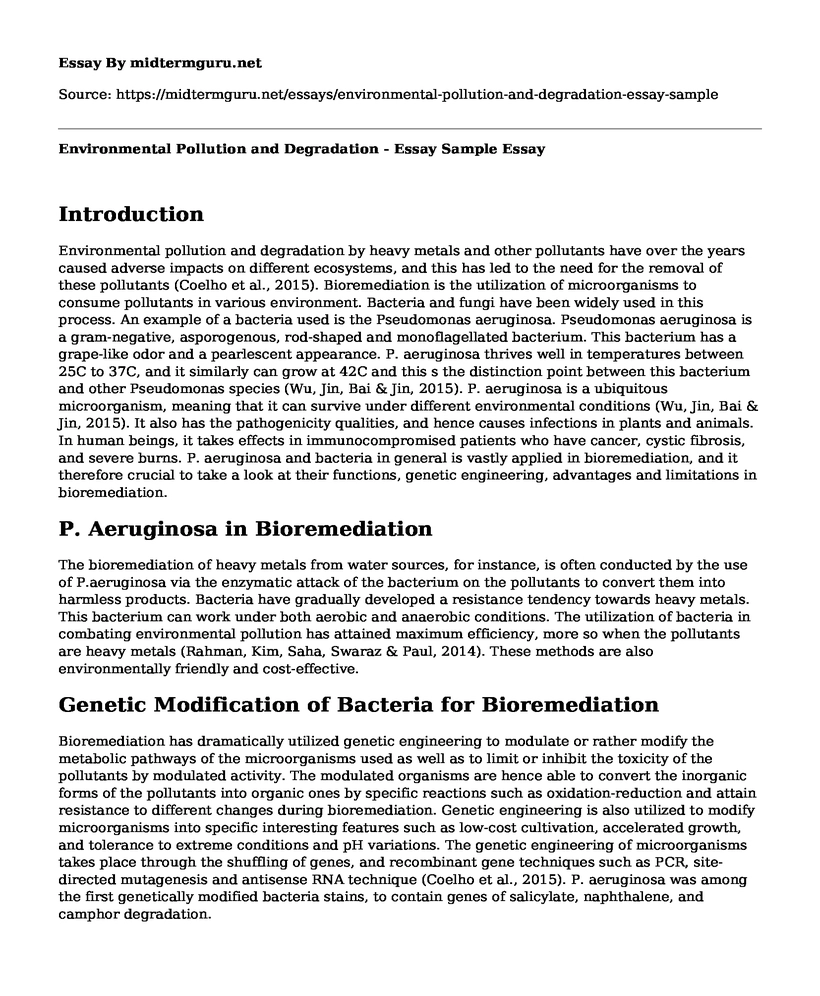Introduction
Environmental pollution and degradation by heavy metals and other pollutants have over the years caused adverse impacts on different ecosystems, and this has led to the need for the removal of these pollutants (Coelho et al., 2015). Bioremediation is the utilization of microorganisms to consume pollutants in various environment. Bacteria and fungi have been widely used in this process. An example of a bacteria used is the Pseudomonas aeruginosa. Pseudomonas aeruginosa is a gram-negative, asporogenous, rod-shaped and monoflagellated bacterium. This bacterium has a grape-like odor and a pearlescent appearance. P. aeruginosa thrives well in temperatures between 25C to 37C, and it similarly can grow at 42C and this s the distinction point between this bacterium and other Pseudomonas species (Wu, Jin, Bai & Jin, 2015). P. aeruginosa is a ubiquitous microorganism, meaning that it can survive under different environmental conditions (Wu, Jin, Bai & Jin, 2015). It also has the pathogenicity qualities, and hence causes infections in plants and animals. In human beings, it takes effects in immunocompromised patients who have cancer, cystic fibrosis, and severe burns. P. aeruginosa and bacteria in general is vastly applied in bioremediation, and it therefore crucial to take a look at their functions, genetic engineering, advantages and limitations in bioremediation.
P. Aeruginosa in Bioremediation
The bioremediation of heavy metals from water sources, for instance, is often conducted by the use of P.aeruginosa via the enzymatic attack of the bacterium on the pollutants to convert them into harmless products. Bacteria have gradually developed a resistance tendency towards heavy metals. This bacterium can work under both aerobic and anaerobic conditions. The utilization of bacteria in combating environmental pollution has attained maximum efficiency, more so when the pollutants are heavy metals (Rahman, Kim, Saha, Swaraz & Paul, 2014). These methods are also environmentally friendly and cost-effective.
Genetic Modification of Bacteria for Bioremediation
Bioremediation has dramatically utilized genetic engineering to modulate or rather modify the metabolic pathways of the microorganisms used as well as to limit or inhibit the toxicity of the pollutants by modulated activity. The modulated organisms are hence able to convert the inorganic forms of the pollutants into organic ones by specific reactions such as oxidation-reduction and attain resistance to different changes during bioremediation. Genetic engineering is also utilized to modify microorganisms into specific interesting features such as low-cost cultivation, accelerated growth, and tolerance to extreme conditions and pH variations. The genetic engineering of microorganisms takes place through the shuffling of genes, and recombinant gene techniques such as PCR, site-directed mutagenesis and antisense RNA technique (Coelho et al., 2015). P. aeruginosa was among the first genetically modified bacteria stains, to contain genes of salicylate, naphthalene, and camphor degradation.
Limitations of Using Bacteria for Bioremediation
The limitations of using bacteria in bioremediation include the formation of toxins during the bioremediation process. This hence creates more pollutants rather than eliminate them. Many bacteria are pathogens, and thus, their unmanaged utilization may result in disease outbreaks and deaths in plants and animals. Biological bioremediation by the use of bacteria and other microorganisms is often slow as compared to chemical interventions, and this might lead to incomplete biodegradation.
Conclusion
Pollution is one of the most disturbing occurrences the 21st century is facing, and it has had adverse effects on the different ecosystems. Many interventions have been hence employed to counter this effect, and among them is bioremediation by utilizing microorganisms. Bacteria are usually used in this process and are efficient, environmentally friendly and cost-effective. Genetic engineering has been applied in bioremediation to enable certain interesting traits in bacteria meant to accelerate the biodegradation process. The use of bacteria has also seen its darker days as it is slower, can cause increased toxicity and are pathogens hence can cause diseases.
References
Coelho L. M., Rezende H. C., Coelho L. M., de Sousa P. A. R., Melo D. F. O & Coelho N. M. M. ( 2015). Bioremediation of pollutes waters using microorganisms. DOI: 10.5772/60770
Kim K. Saha S. K., Swaraz A. M., & Paul D. K. (2014). Review of remediation techniques for arsenic (As) contamination: A novel approach utilizing bio-organisms. Journal of Environmental Management. 134. Pp. 175-185. https://doi.org/10.1016/j.jenvman.2013.12.027
Wu W., Jin Y., Bai F. & Jin S. (2015). Molecular medical microbiology. 2nd edition. Academic press. vol. 2. Pp. 753-767. https://doi.org/10.1016/B978-0-12-397169-2.00041-X
Cite this page
Environmental Pollution and Degradation - Essay Sample. (2023, Jan 04). Retrieved from https://midtermguru.com/essays/environmental-pollution-and-degradation-essay-sample
If you are the original author of this essay and no longer wish to have it published on the midtermguru.com website, please click below to request its removal:
- Essay on Reproductive Techniques and Technologies: Cohen and Mcmahan
- Effects of Mountaintop Coal Mining and the Deepwater Horizon Oil Spill - Paper Example
- Research Paper on Lifestyle Behaviors and Their Impacts On the Environment
- Essay Sample on Haiti Earthquake
- Nature: Our Lifeline That Needs Preserving - Essay Sample
- Research Paper on Effects of Telomeres on Mammalian Life History
- Solving Environmental Issues Globally - Research Paper







